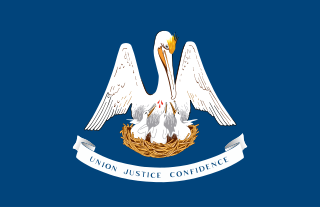
The Great Seal is a principal national symbol of the United States. The phrase is used both for the physical seal itself, which is kept by the United States Secretary of State, and more generally for the design impressed upon it. The obverse of the Great Seal depicts the national coat of arms of the United States while the reverse features an unfinished pyramid topped by an Eye of Providence. The year of the U.S. Declaration of Independence, 1776, is noted in Roman numerals at the base of the pyramid. The seal contains three Latin phrases: E Pluribus Unum, Annuit cœptis, and Novus ordo seclorum.

The flag of Louisiana consists of a rectangular field of blue with the arms of Louisiana, the pelican vulning herself, in white in the center, with a ribbon beneath, also in white, containing in blue the state motto: "Union Justice Confidence." The flag was officially adopted July 1, 1912, and is often referred to as the Pelican flag.

The flag of the state of Montana consists of the image of the Montana state seal centered on a blue field.

The flag of the state of Vermont displays the coat of arms and motto of the U.S. state of Vermont on a rectangular blue background. The Vermont General Assembly adopted this flag on June 1, 1923.

The Eye of Providence is a figure that depicts an eye, often enclosed in a triangle and surrounded by rays of light or glory, meant to represent divine providence whereby the eye of God watches over humanity. The Eye of Providence is a widely recognized symbol, giving it instrumentality in the fields of iconography and semiotics. A well known example of the Eye of Providence appears on the reverse of the Great Seal of the United States, which is depicted on the United States one-dollar bill.

The coat of arms of Ukraine is a blue shield with a gold trident. Officially referred to as the Emblem of the Royal State of Volodymyr the Great, or, colloquially, the tryzub, the insignia derives from the seal-trident of Volodymyr the Great, the first Grand Prince of Kyiv.

The Great Seal of the State of Michigan depicts the coat of arms of the U.S. state of Michigan on a light blue field. On the dark blue shield the Sun rises over a lake and peninsula, a man holding a long gun with a raised hand represents peace and the ability to defend his rights. The elk and moose are symbols of Michigan, while the bald eagle represents the United States.

The Great Seal of the State of Iowa was created in 1847 and depicts a citizen soldier standing in a wheat field surrounded by symbols including farming, mining, and transportation with the Mississippi River in the background. An eagle overhead bears the state motto.
National symbols of the United States are the symbols used to represent the United States of America.

The Seal of the State of Texas was adopted through the 1845 Texas Constitution, and was based on the seal of the Republic of Texas, which dates from January 25, 1839.

Audemus jura nostra defendere — Latin for "We Dare Defend Our Rights" or "We Dare Maintain Our Rights" — is the state motto of Alabama and is depicted on the official Coat of arms of Alabama. The current coat of arms was created in 1923 at the request of state historian and director of the Alabama Department of Archives and History, Marie Bankhead Owen. It was not officially adopted until March 14, 1939. The motto itself is emblazoned on a golden band across the bottom of the coat of arms. The escutcheon of the coat of arms is quartered into the flags of the Kingdom of France, the Crown of Castile, the United Kingdom of Great Britain and Ireland, and the Confederate States of America, with a central overlay of the shield of the United States. Bald eagles serve as supporters to either side of the escutcheon. All is surmounted by a crimson and white torse and the Baldine, the sailing ship that Iberville and Bienville arrived in prior to the settlement of the colony of Mobile.

The Great Seal of the State of Illinois is the official emblem of the U.S. state, and signifies the official nature of a document produced by the state of Illinois. The flag of the state of Illinois consists of the seal of Illinois on a white background, with the word "Illinois" underneath the seal. The present seal was adopted in 1869, the flag bearing the central elements of the seal was adopted in 1915, and the word Illinois was added to the flag in 1970. In a 2001 survey by the North American Vexillological Association, the flag of Illinois was ranked 49th out of 72 different flags of states and territories, mainly in the US and Canada.

The seal of the Territory of Idaho was adopted in 1863 and redrawn several times before statehood in 1890. The state Great Seal was designed by Emma Edwards Green, the only woman to design a U.S. state seal.

The Seal of the State of Oregon is the official seal of the U.S. state of Oregon. It was designed by Harvey Gordon in 1857, two years before Oregon was admitted to the Union. The seal was preceded by the Salmon Seal of the Provisional Government and the Seal of the Oregon Territory. The state seal is mandated by Article VI of the Oregon Constitution.

The Great Seal of the Commonwealth of Massachusetts contains the coat of arms of Massachusetts. The coat of arms is encircled by the Latin text "Sigillum Reipublicæ Massachusettensis". The Massachusetts Constitution designates the form of government a "commonwealth", for which Respublica is the correct Latin term. The Seal uses as its central element the Coat of Arms of Massachusetts. An official emblem of the State, the Coat of Arms was adopted by the Legislature in 1775, and then reaffirmed by Governor John Hancock and his Council on December 13, 1780. The present rendition of the seal was drawn by resident-artist Edmund H. Garrett, and was adopted by the state in 1900. While the inscription around the seal is officially in Latin, a variant with "Commonwealth of Massachusetts" in English is also sometimes used.

The Flag of the City and County of San Francisco is the municipal flag of San Francisco, California. The flag's central symbol, a rising phoenix, often is assumed to refer to the city's recovery from the 1906 earthquake and subsequent fires. However, the phoenix had been a civic symbol of San Francisco at least since 1852, when it featured on the first official seal of the City. The Board of Supervisors of the City and County of San Francisco codified the design of the current flag on December 16, 1940.

















